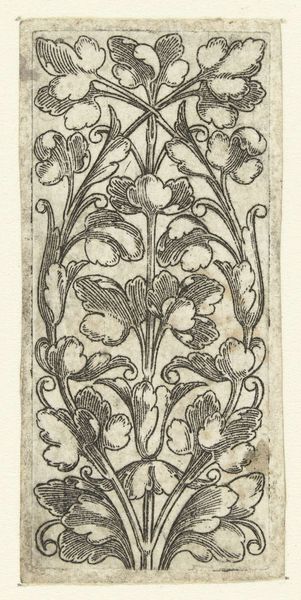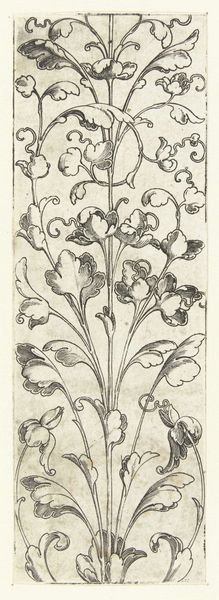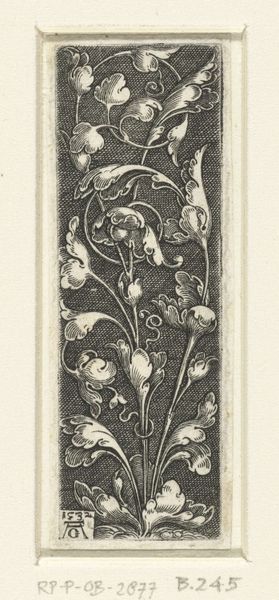
print, engraving
# print
#
11_renaissance
#
geometric
#
line
#
northern-renaissance
#
engraving
Dimensions: height 58 mm, width 25 mm
Copyright: Rijks Museum: Open Domain
Curator: This striking image is entitled "Kaarsrechte stengel", dating back to between 1500 and 1600, made by an anonymous artist. The medium is an engraving. Editor: Immediately, the stark black lines give it such a firm, assertive quality despite its delicate botanical subject. It’s like a statement on nature. Curator: Yes, the linework is characteristic of the Northern Renaissance, focusing on detail and pattern. I think these weren't just decorative; plants often had symbolic meaning in this era. It’s almost as if it’s a secret language that was being shared. Editor: Interesting… almost a clandestine visual discourse of the time! One must consider what this supposed symbolism really entailed…perhaps some level of political rebellion. Look how the vertical line defies gravity as we interpret the direction upwards. It becomes charged with aspirations. Curator: Possibly so. This insistence on linear perspective adds to the dynamic upward sweep. What reads clearly to our modern eyes—almost geometrically—may have alluded to something else entirely. Editor: Right, but this ‘Kaarsrechte stengel’ isn't merely decorative in a neutral sense. It's engaging with social concepts and anxieties of the era. To the common person, what power was hidden in the stem's upward mobility or nature's visual language that would change history? I am convinced, if read politically, its decorative impact challenges its pure aesthetic nature. Curator: That makes me consider the potential alchemical or religious symbolism too… that continuous vertical could signify spiritual ascent, in addition to the political subtext. Or something entirely practical like design elements, since this piece may have functioned as a pattern for artisans. Editor: Or the rise in a new socioeconomic system! The very means of print making was innovative in making distribution of symbols accessible. How did such images democratize symbolism at the time, as well as perhaps control and commodify nature in an artful way? Curator: Whether intended as purely ornamental, propagandistic, or with layers of hidden allegory, this print definitely offers much food for thought about the complex relationship between nature, power, and symbolism during the Renaissance. Editor: I couldn't agree more. It's amazing how a relatively simple image like this can ignite a discussion that touches on everything from social uprising, politics and secret languages to personal beliefs and innovation. A piece for today, even with such early roots!
Comments
No comments
Be the first to comment and join the conversation on the ultimate creative platform.













